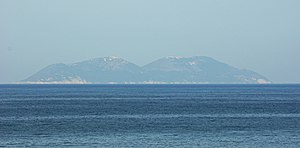Sazan
| Sazan | ||
|---|---|---|
| Sazan from the southeast | ||
| Waters | Bay of Vlora , Adriatic Sea | |
| Geographical location | 40 ° 29 '37 " N , 19 ° 16' 50" E | |
|
|
||
| length | 4.7 km | |
| width | 2 km | |
| surface | 5.7 km² | |
| Highest elevation | 342 m | |
| Residents | uninhabited | |
| Numerous bunkers and military structures on the west coast of the island | ||
Sazan ( Albanian also Sazani , Italian Saseno , Greek Σάσων Sason , Latin Saso ) is a small island on the Albanian Adriatic coast . The island is strategically located at the entrance to the Bay of Vlora and the Strait of Otranto , the transition from the Adriatic to the Ionian Sea . Sazan is uninhabited. The island has an area of just under six square kilometers and is not quite five kilometers north of the Karaburun peninsula , the northern foothills of the Ceraunic Mountains , or a little more than eight kilometers west of the coast near Zvernec, a village north of Vlora.
With the exception of a section in front of the port, the coast in front of the island is part of the Karaburun-Sazan Marine National Park, founded in 2010 .
history
The island belonged to the Republic of Venice until 1796 and then to the Republic of the Ionian Islands , which joined the Kingdom of Greece in 1864 . During the First World War, Italy occupied Sazan on October 30, 1914. In a secret treaty in April 1915, Italy secured the area around Vlora and the offshore island. When Albanian troops drove the Italians from the Albanian mainland after the war, the conflicting parties agreed in a protocol on August 2, 1920 that at least Sazan would remain under Italian sovereignty. Italy maintained a military base on the island. As the daughter of the island's commander in chief, the Italian journalist and writer Caterina (Rita) Durante (1928-2004) spent her childhood years on the island with her mother and sisters until the Second World War .
Only after the end of the Second World War did the now communist Albania gain control of the island in accordance with the peace treaty of February 10, 1947. Subsequently, the island was also used as a base by Soviet troops until the break between Tirana and Moscow in 1960 . A small settlement was built on the island with houses for the relatives of the soldiers, a cinema and a school. A chemical weapons factory is also said to have operated on Sazan.
Future development
Today Sazan is still used as a base by the Albanian Navy . The Italian customs authorities also operate from here against Albanian smugglers' gangs. A number of yachts have already called the island on the north-east side as a port of refuge due to bad weather, which is tolerated by the crews of the Italian coast guard boats stationed there, as permitted by maritime law.
The Albanian Ministry of Tourism has repeatedly drawn up plans to turn the island into a holiday destination with hotels and a casino. However, the problem is that the island has no fresh water sources.
In the summer of 2015 it was possible for tourists to explore the island in groups from Vlora by excursion boat.
philately
In 1923, eight Italian postage stamps were overprinted with SASENO .
cards
literature
- Björn Berge: Atlas of the vanished countries: world history in 50 stamps . dtv, Munich 2018, ISBN 978-3-423-28160-7 , Childhood Paradise in the Most Boring Place in the World, p. 174 ff .
Web links
- Italian TV report about the island and the naval base on YouTube
- Albanian military island is to become a tourist attraction
Individual evidence
- ↑ John Beck: This island used to be a top-secret military base. Now the government wants to open it to tourists. In: Roads & Kingdoms. September 4, 2018, accessed December 22, 2018 .
- ↑ AFP : Sazan, une île-bunker d'Albanie ouverte aux touristes. In: Le Soir . August 13, 2015, accessed on August 14, 2015 (French, with video).





